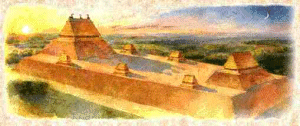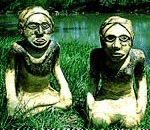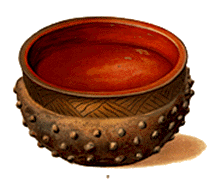|
"It is altogether unknown to us what could have induced the Indians to raise such a heap of earth in this place . . . It is reasonable to suppose, however, that they were to serve some important purpose in those days, as they were public works, and would have required the united labour and attention of a whole nation." THE MOUND BUILDERS SIXTEEN HUNDRED YEARS AGO, the lower Mississippi Delta was home to some of the most highly organized civilizations in the world. There were roads, commerce, and metropolises anchored by awe-inspiring earthen monuments. Wonders of geometric precision, these earthworks were the centers of life. As was the river itself. The alluvial soil of its banks yielded an unprecedented bounty of beans, squash, and corn to foster the burgeoning communities of the lower Mississippi valley. Over its waters, from near and far, came prized pearls, copper, and mica.
Today, little is left of the moundbuilders' legacy. Through the efforts of the Lower Mississippi Delta Region Initiative, the National Park Service is working to identify resources and recommend methods to protect, preserve, and interpret the significant natural, cultural, and recreational resources of this region.
NORTHERN GEORGIA
SOURCE: National Park Service and Etowah Mounds Archaeological Area Web Sites. |
All rights reserved. For details and contact information: See License Agreement, Copyright Notice. |
 The first Europeans in the Delta, arriving in the 1500s, paid little attention to the mysterious earthworks, by now mostly abandoned remnants of another time. But curiosity began in earnest around 1848. Literary fantasies abounded, with a "moundbuilders theory" hypothesizing that a "people of great intelligence and skill" had simply disappeared, perhaps to South America.
The first Europeans in the Delta, arriving in the 1500s, paid little attention to the mysterious earthworks, by now mostly abandoned remnants of another time. But curiosity began in earnest around 1848. Literary fantasies abounded, with a "moundbuilders theory" hypothesizing that a "people of great intelligence and skill" had simply disappeared, perhaps to South America.  Their earthworks have been plowed, pilfered, eroded, and built over. This page is part of the effort to stop the destruction. It is hoped that in understanding the contributions of these ancient Americans, it will become clear why we must preserve the rich heritage that remains along the banks of the lower Mississippi.
Their earthworks have been plowed, pilfered, eroded, and built over. This page is part of the effort to stop the destruction. It is hoped that in understanding the contributions of these ancient Americans, it will become clear why we must preserve the rich heritage that remains along the banks of the lower Mississippi.
 Etowah Mounds Archaeological Area and museum offers visitors a view of a society rich in ritual and artifacts. The collections in the museum include items of shell, ceramics, wood, copper, bone, stone, and textiles. These artifacts came from what was North Georgia's largest town when Hernando DeSoto arrived. You can still see
evidence of this thriving town. The largest mound stands 63 feet above the sandy loam of the Etowah River Valley which the Indians so successfully farmed.
Etowah Mounds Archaeological Area and museum offers visitors a view of a society rich in ritual and artifacts. The collections in the museum include items of shell, ceramics, wood, copper, bone, stone, and textiles. These artifacts came from what was North Georgia's largest town when Hernando DeSoto arrived. You can still see
evidence of this thriving town. The largest mound stands 63 feet above the sandy loam of the Etowah River Valley which the Indians so successfully farmed.